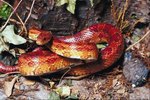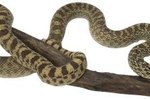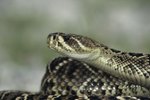
Snakes exhibit an astounding array of colors and patterns, from dull and inconspicuous markings to some of the most visually stunning ornamentation on earth. Blue or blue-ringed snakes exist in nature, but only in a few species. Less dramatic tones are more common among snake species.
The Land-Living Sea Snake
Most commonly found in shallow, tropical waters of Southeast Asia and the Pacific, blue sea kraits have bands of pale blue, gray or deep blue alternating with black. These snakes are extremely venomous but fortunately are not aggressive. Unlike other sea snakes, kraits live on land for several days at a time, usually to digest their food or lay eggs. Blue kraits reach 30 to 50 inches in length, with the females significantly larger.
Snake in the Hood
The Egyptian banded cobra reaches 8 feet in length and can raise his head 2 feet off the ground when threatened. The bands can be blue, blue-black or black. This highly venomous snake also displays a distinctive hood that reach 5 inches wide when flexed.
Baby Rings
Though adults are solid blue, black or gray, juvenile black racers and eastern rat snakes have blotches of brown, red or black on a gray or blue-gray background, giving the appearance of blue rings. Growing to 5 feet long, the slender black racers are found throughout the eastern United States. The eastern rat snake reaches 6 feet in length and inhabits New England, south through Georgia and west to Louisiana and Oklahoma.
Longitudinal Rings
One striking example of blue coloration in snakes is the blue-striped garter. With a base coloration of blue-black, the snake has several blue stripes that can be palest blue or darkest navy down his length. Found only in western Florida, this snakes reaches 20 to 30 inches in length -- females are larger -- and prefer marshes and pine forests. Juveniles are solid in color and grow into their stripes as they reach adulthood.
References
- Biodiversity Explorer: Naja Annulifera (Snouted Cobra, Egyptian Cobra, Banded Cobra)
- National Geographic: The Ocean: Banded Sea Krait
- Aquarium of the Pacific: Banded Sea Krait
- Smithsonian National Zoological Park: Banded Egyptian Cobra
- Savannah River Ecological Laboratory: Black Racer (Coluber Constrictor)
- Verginia Herpetological Society: Eastern Ratsnake
- University of Florida: Herpetology: Bluestripe Garter Snake
Photo Credits
-
Tom Brakefield/Stockbyte/Getty Images
Writer Bio
Leslie Darling has been a writer since 2003, writing regularly for "Mississippi Magazine" and "South Mississippi Living," specializing in food and wine, animals and pets, and all things Southern. She is a graduate of the University of New Orleans.




